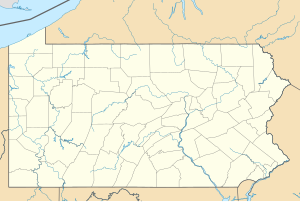Kinzua Dam
| Kinzua Dam Allegheny Reservoir |
|||||||||
|---|---|---|---|---|---|---|---|---|---|
| View to the southeast to the Kinzua Dam with a small section of the Allegheny Reservoir, which continues to the left | |||||||||
|
|||||||||
|
|
|||||||||
| Coordinates | 41 ° 50 ′ 19 ″ N , 79 ° 0 ′ 13 ″ W | ||||||||
| Data on the structure | |||||||||
| Lock type: | Dam + dam wall | ||||||||
| Construction time: | 1960-1965 | ||||||||
| Height of the barrier structure : | 55 m | ||||||||
| Crown length: | 578 m | ||||||||
| Base width: | 379 m | ||||||||
| Data on the reservoir | |||||||||
| Water surface | 85.7 km² | ||||||||
| Reservoir length | 29 km | ||||||||
| Reservoir width | 1 km | ||||||||
| Maximum depth | 40 m | ||||||||
| Storage space | 707 million m³ | ||||||||
| Total storage space : | 1.6 billion m³ | ||||||||
| The Kinzua Dam looking west and downstream. On the hills, the Seneca pumped storage reservoir ( pumped storage plant ) to see | |||||||||
| View from the dam on the reservoir in a north-northwest direction. A bridge on Pennsylvania State Route 59 crosses the lake | |||||||||
The Kinzua Dam is located in the US state of Pennsylvania and dams the Allegheny River to the Allegheny Reservoir . It is one of the largest dams in the United States east of the Mississippi .
geography
The dam is located 6 miles east of Warren just off Pennsylvania State Route 59 . It is embedded in the Allegheny National Forest .
history
The plans for the construction of a dam on the Allegheny River go back to the 1930s . Permits were granted three times (1936, 1938, and 1941) before construction actually began in 1960. The client was the United States Army Corps of Engineers . Five years later, the dam was completed - it cost $ 108 million .
When Hurricane Agnes moved unusually far north in 1972 , days of heavy rain fell on the upper reaches of the Allegheny River. The reservoir reached a record high and was only 91 cm from its maximum capacity. The damming prevented flooding of the downstream areas, which would probably have caused damage of around 247,000,000 US dollars.
Resettlement
The construction of the dam was extremely controversial, because a whole Indian people had to give way for it. The last indigenous people of Pennsylvania, the Seneca, had to be resettled from their original areas, which would have been in the north of the emerging lake, to the area around Salamanca in the US state of New York . Today there is the Allegany reservation again on the northern banks of the reservoir . In 1964 , Johnny Cash wrote the song As Long as the Grass Shall Grow about the forced resettlement of the Indians on his album Bitter Tears: Ballads of the American Indian .
With the support of the Quakers , the Seneca Nation fought for compensation. After a long legal battle, the Seneca received a total of $ 15,000,573 for lost land and homes. The most important compensation was the resettlement of around a hundred Seneca families in the two new villages of Jimersontown and Steamburg. On June 12, 1965, the nave fire, accompanied by a ceremony, was brought from Coldspring to Steamburg. The construction of several public buildings in Cattaraugus County and the Allegany Reservation, including a high school, also count towards compensation.
In 2011, at an official ceremony, a white collector donated one of the first documents of a protest against the construction of the dam to the tribe's archives. In 1956, 122 "mothers" called on their official representatives with this petition to fight against the building, which was then passed on December 4, 1956 with a resolution. The men had submitted a parallel petition.
The Boy Scout Camp “Olmsted” on the banks of the river was also demolished. It was rebuilt earlier.
Sense of the dam
The main benefit of the project is flood protection . It is intended to control the runoff of the Allegheny River and the Ohio River . In addition, the dam regulates irrigation in a catchment area of 5,644 km².
Useful side effects are protection against drought, electricity generation and the creation of a local recreation area.
investment
Dam wall
The dam consists of an earth wall and an adjoining concrete dam . Together they have a length of 578 m. The wall consists of 2,293,635 m³ of earth, the wall of 382,272 m³ of concrete . The height of the dam is 55 meters.
There is a hydroelectric power station in the dam . The pipes that run through the dam wall have a diameter of 5.8 m.
Reservoir
The lake created by the damming, the Allegheny Reservoir, is one of the deepest lakes in Pennsylvania with a depth of almost 40 meters. It has a length of 29 km and a maximum width of about 1 km.
tourism
Until September 11, 2001, the dam was open for guided tours. After the terrorist attacks , however, these were suspended for reasons of national security.
However, it is still possible to swim in the lake, to which some small beaches invite. There is also a marina not far from the dam . There is also a house with a tourist information office on the street about 200 m below the dam.
Web links
notes
- ↑ Historic Document Opposing Kinzua Dam Returned to Seneca Nation , Indian Country today, March 15, 2011, with the text of the tribal resolution December 4, 1956



